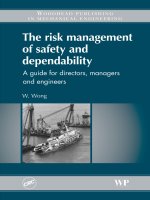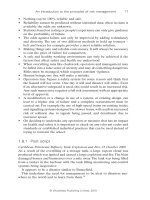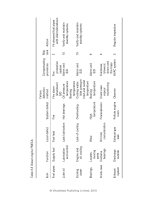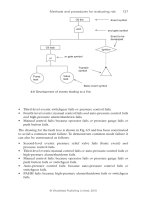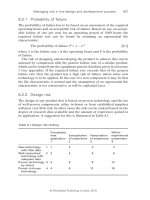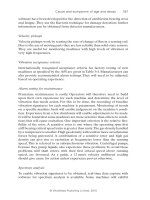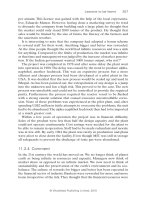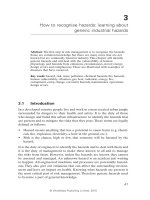RESOURCES AT RISK: THE COORDINATED MANAGEMENT OF MEANING AND STUDY ABROAD
Bạn đang xem bản rút gọn của tài liệu. Xem và tải ngay bản đầy đủ của tài liệu tại đây (583 KB, 116 trang )
1
RESOURCES AT RISK: THE COORDINATED MANAGEMENT OF MEANING
AND STUDY ABROAD
Nicholas Patrick Noblet
Submitted to the faculty of the University Graduate School
in partial fulfillment of the requirements
for the degree
Master of Arts
in the Department of Communication Studies,
Indiana University
August 2011
ii
Accepted by the Faculty of Indiana University, in partial
fulfillment of the requirements for the degree of Master of Arts.
_____________________________
John Parrish-Sprowl, Ph.D., Chair
Master’s Thesis
Committee
_____________________________
Ronald Sandwina, Ph.D.
_____________________________
Elizabeth Goering, Ph.D.
iii
Acknowledgements
I have many people to acknowledge for the completion of this thesis, beginning
first with my committee. Dr. John Parrish-Sprowl was absolutely instrumental in this
study, and I truly value his mentorship and guidance. Dr. Sandwina and Dr. Goering also
provided valuable input that helped shape me as a scholar and shape this project’s
direction. The students I had the privilege of working with, before and after their study
abroad experiences, deserve acknowledgement for their generosity of time and depth of
response. My wonderful peers during my graduate study helped me along the path to
completion, and deserve special recognition for the experience I received. Finally, my
family and friends helped keep me focused on the end. For everyone special in my life, I
am truly thankful.
iv
Abstract
Nicholas Patrick Noblet
RESOURCES AT RISK: THE COORDINATED MANAGEMENT OF MEANING
AND STUDY ABROAD
This study seeks to elucidate the concept of resources at risk as detailed in the
Coordinated Management of Meaning (CMM) theoretical framework. Risk is the
possibility that a communicator’s resources are in jeopardy of change, and this study
seeks to explicate how a communicator places his or her resources at risk. An
undergraduate spring break study abroad program was selected as the context for this
examination, with six students participating in before and after interviews. Results
showed that three types of resources at risk were identified, with a fourth type unable to
be identified through transcript analysis. This study demonstrates theoretical and
practical implications that further the understanding of CMM and its execution. In
addition, limitations and areas for future research are discussed.
John Parrish-Sprowl, Ph.D., Chair
v
Table of Contents
1: Introduction 1
2: Literature Review 4
3: Methods 27
4: Analysis & Discussion 30
Appendix A: Student Interview Guides 46
Appendix B: Student Interview Transcripts 47
References 102
Curriculum Vitae
1
1: Introduction
The Coordinated Management of Meaning (CMM) theory, developed by Pearce
and Cronen (1976, 1989), is an “…invitation to use some concepts and tools to think
about very familiar things and see them in a new way” (Pearce, 2007, p. ix). CMM offers
a unique and productive way to view the condition of being human. From its inception,
CMM has undergone clarification and development from many scholars. It is in this
spirit of augmentation and experimentation which the present study seeks to fill a void.
A brief understanding of CMM is requisite and will be provided to view the proposed
theory elucidation in context. More depth will be covered in the literature review, but for
introductory purposes, CMM can be thought of as a way of viewing the world. Our
world is socially constructed, designed by persons in concert with each other.
Communication is the central aspect of existence. According to Pearce (1989),
communication is “…a recurring, reflexive process in which resources are expressed in
practices and in which practices (re)construct resources” (p. 23). Practices are the acts by
which communication occurs, and resources are the materials that inform practices. After
that is known, coordination, coherence and mystery are the descriptors by which
communication is articulated. There are forms of communication that rely on
expressions of practices and resources, as well as other intricacies, but these basics make
up the communication perspective. The suggested area for illumination is the concept of
resources, to further clarify and specify how these are put into practice and risk. By
better understanding this CMM can be more thoroughly translated to everyday
experience and application by those who choose to use it.
Part of CMM is the concept of putting resources, as outlined above, at risk.
Within CMM, risk is the possibility that a communicator’s resources are in jeopardy of
2
change. Risk is done differently in each form of communication, but the theory only
accounts for a binary choice; either resources are placed at risk, or they are not. In each
form, risk is explicated. In monocultural and ethnocentric communication resources are
not at risk. Modernistic communication continually places resources at risk, and
cosmopolitan communication allows for the choice of placing resources at risk.
According to Parrish-Sprowl (in press), there are four ways in which resources are placed
at risk: restorying, obsolescence, forgetting, and challenging. Restorying is the process of
learning a different understanding on a given topic; an example would be a child’s
understanding of birth, from the stork to parental conception. Obsolescence is considered
resources that are no longer put into active practice; an example would be the evolution
of technology and understanding, such as skills associated with cassette tapes to CDs to
mp3s. Forgetting is the process by which resources are no longer part of a person’s
collection, which is different from obsolescence; obsolescence can lead to forgetting, but
they are two distinct ways of placing resources at risk. An example would be forgetting
how to write certain letters of the cursive alphabet. Finally, challenging is the process by
which resources are remade by conflict with a different set of resources outside of a given
person; an example would be learning a proper method for advanced mathematical
calculation differently from multiple instructors. This is different from restorying, as
challenge comes from a conflict of two sets of resources, and ultimately results in
reshaping resources based on that conflict. Restorying is the evolution of a set of
resources within a given communicator by negotiating the differences; it can be seen as
an augmentation of an existing set of resources, rather than a conflictual redefinition.
These four ways define the process of putting resources at risk, and are a valuable
3
addition to the theory. However, these four categories have not been tested in any
context to date. This creates the aforementioned void this study seeks to fill.
The context selected for testing of the above concepts is that of study abroad.
There is an extensive collection of literature on the benefits, challenges and
considerations concerning undergraduate study abroad, and those are addressed in the
literature review. For the present study purposes, study abroad provided the best
opportunity to examine students in a new situation that would enhance the opportunity
for putting one’s resources at risk. In specific program selection, a spring break study
program was selected, lasting one week. It is also important to note that a program was
selected in the same native language as the students; this enhanced the possibility for
interactions outside of the student culture and hopefully fostered interactions that placed
students’ resources at risk. London, England provided the location for the study abroad,
and six student participants volunteered to conduct qualitative interviews before and
after. This allowed students to recall critical moments of interaction, and produced
narrative transcripts of conversation for analysis. Given study abroad and CMM, the
background is now set for an examination of putting one’s resources at risk, and the ways
in which that occurs. In summary, this study seeks to use undergraduate study abroad to
examine the four types of resources at risk (Parrish-Sprowl, in press), and describe their
existence within that context.
4
2: Literature Review
Following a general introduction, the literature applicable to this study will be
divided into five sections: a) the theory itself, b) a general overview of study abroad, c)
the international aspect of study, d) the need for study abroad and pre-departure
considerations, and finally e) a focus on short-term study abroad. Beginning first with
introductory works, the creation of this study stems from similar investigations; notably,
those of Pearce’s theory extension mentioned later and Miner’s (2008) phenomenological
study of study abroad. Miner studied the experience of becoming mindful of culture via
study abroad, and this study will use a similar conversational experience to demonstrate
theory elucidation. Whereas Miner’s perspective was phenomenological, this study seeks
to use a CMM perspective. However, many insights can be shared across both studies.
For example, the value of identity and conversational experience comes through as
“[i]dentity is negotiated throughout the experience and relational associations make the
experience possible” (Miner, 2008, p. 173). She continues on, as “[r]elational
associations are sources of contrast as well as sources of learning and deeper
understanding” (Miner, 2008, p. 174). She concludes that “[t]he current study shows that
the more open a person is in their relational associations, the richer the person’s
understanding and cultural learning” (Miner, 2008, p. 178). Ultimately, “[a] willingness
to open oneself up to the idea of change and opening eyes to enlarged fields of vision also
allows humans today to travel further – not necessarily in physical distance, but
absolutely necessarily in depth and potential of personal experience and legitimacy in
alternative experiences” (Miner, 2008, p. 176). This study seeks to further explain that
notion of change in one’s self, and the openness to allow it to happen through a
5
communication perspective. In this discussion, it is important to note the population
being studied is that of undergraduates in the United States. Shrestha (2009), using
Michigan State University as a background, provides a comprehensive look at
undergraduate life. The study gives a portrait of experience and an economy of time that
provides depth of understanding for the undergraduate subjects presented. Students spent
more time working, relaxing and socializing than preparing for class (Shrestha, 2009, p.
72), which is significant given that the focus of this study is founded in the conversations
that students have abroad, not necessarily in class or other designated spaces. While
introductory, these works illustrate a general view on the phenomenon under
investigation. Now an understanding of CMM can further complement the study.
The Coordinated Management of Meaning (CMM)
The focus of this research, as previously mentioned, is that of theory elucidation
regarding CMM. A thick description of CMM, works calling for use and application, and
the necessary framework and environment constitute the pertinent CMM literature.
CMM was created by Pearce and Cronen in the late twentieth century. The first work
published by Pearce came out in 1976, followed by Communication and the Human
Condition (1989) and Making Social Worlds: A Communication Perspective (2007). For
this exploration, more of the 1989 work will be detailed. Overall, this is an
encompassing framework, with many key terms that are used frequently; they will be
outlined below as part of the background.
Beginning with the communication perspective, it is born out of a social
construction point of view; meaning that the act of communication constitutes the reality
we collaboratively engage in. Our communication creates, shapes, and changes our
6
shared realities with each word, gesture, or meaning; in this act, the discussion shifts
from objectivity to subjectivity. A thing is no longer objectively able to be described
from a bystander’s point of view, but rather the communication in which it is created is
discussed and framed. Importantly, the act of communication can be thought of as a
reflexive cycle involving practices and resources. Practices are the acts by which
communication occurs, such as speaking to a class or signing a petition. Resources are
the materials that inform practices; for example, the knowledge of a social issue or the
experience of being in a given situation. According to Pearce (1989), “[i]n this sense,
‘practices’ consist in actions such as building a bridge, playing bridge, and seeking to
bridge misunderstandings; ‘resources’ comprise the stories, images, symbols, and
institutions that persons use to make their world meaningful” (p. 23). Focusing then on
resources, “[l]ike other terms, ‘resources’ is deliberately ambiguous. It includes all those
stories, concepts, perceptions, memories, and so forth, by which persons make their
world coherent. Today’s conversation is guided by resources, and the memory of that
conversation becomes part of the resources that guide our conversations tonight” (Pearce,
1989, p. 39). The reflexivity occurs between the two; every new practice changes the
resource which originally informed the practice, and so forth. “The communication
perspective sees all forms of human activity as a recurring, reflexive process in which
resources are expressed in practices and in which practices (re)construct resources”
(Pearce, 1989, p. 23). Pearce (1989) elaborates with “[t]he communication perspective
directs attention to the resources that shape and guide practices, often in subtle ways.
Resources and practices are coevolutionary; each is the ‘cause’ and each the ‘effect’ of
the other. I sometimes indicate this ongoing reciprocal process by using a parenthesis:
7
practices (re)construct resources” (p. 24). Further clarifying, Pearce (1989) states that in
terms of interaction, practices express resources in a number of ways: they express
resources not all at once (p. 40), not necessarily accurately (p. 41), in a nonsummative
fashion (p. 43), and asymmetrically (p. 43).
Figure 1. The “communication perspective”. This figure illustrates the reflexive nature of
communication (Pearce, 1989, p. 24).
In an examination of the above model, Pearce (1989) provides insight: “[t]he
model of the communication perspective…shows a circular relationship between
practices and resources. In any given practice, resources are drawn upon as a guide for
interpretation and action. However, the outer brackets…show a process by which
communicators monitor the unfolding pattern of action in which they participate, and
make judgments about what is happening. These perceptions of today’s practices
8
become part of tomorrow’s resources” (p. 45). In the expression of practices and
resources, Pearce (1989) also notes that resources are seldom fully consistent in their
expression (p. 46). In that same expression, he notes that “[r]esources are expressed in
practices, because resources comprise a ‘logic’ of meaning and action that defines what is
obligatory, legitimate, dubious, or prohibited” (Pearce, 1989, p. 39). Thus the idea of
force is born, including the four identified types: prefigurative, practical, contextual and
implicative (Pearce, 1989, p. 40). While not as useful to the present focus, the work cited
in the references section provides a more complete look at the types of force and their
relation to the above model. Finally, perhaps the most accurate summation of resources
comes as follows: “[t]he event/objects of social reality are not performed as a single act;
they are the product of an unfolding sequence of messages performed serially (and
sometimes simultaneously) by multiple persons, who may well be trying to express
different resources” (Pearce, 1989, p. 40). Taken together, these concepts make up the
basics of the communication perspective.
After those assumptions are made, the perspective takes on three elements, central
to communication: coordination, coherence, and mystery. Coordination is the act of
managing meaning between persons; it is the attempt to convey something through
communication to another. Coherence is the understanding inherent in each person; it is
the stories we share with ourselves and others to make sense of our environment.
Mystery is the knowledge of limitations, that no matter how many stories we accrue,
there are more to be understood and available in our larger world. These three terms
make up the communication perspective and give framing to intercultural communication
as noted below.
9
Beyond the framework’s intricacies there are four different types of
communication and labels used to describe each: monocultural, ethnocentric, modernity,
cosmopolitan. Each of these possesses unique characteristics and views of
communication. To clarify, Pearce (1989) poses that “[t]o get at these characteristics is
to focus on the extent to which the participants treat each other ‘like a native’ and
whether they put their resources ‘at risk’” (p. 92). In each form of communication, there
is a different combination and focus of treating others like a ‘native’ and placing one’s
resources at risk of change. He continues further by stating that “[p]rotecting your
resources from risk refers to the suspension of disbelief that comes from deep
enmeshment in your own stories. To put your resources at risk means reading your
stories with a willing suspension of belief, comparing them with the emerging pattern of
communication, intending to change them if it seems appropriate. The tensions among
these ways of treating other persons and your own resources comprise the various aspects
of giving stories ‘a good reading’” (Pearce, 1989, p. 92). He states that we usually try to
identify what resources the other is expressing, although we truly cannot know (Pearce,
1989, p. 92). He makes this point by stating that “[u]sually we assume that others are
pretty much like us, and that we ‘know’ their resources because they are the same ones
that we have appropriated from our culture” (Pearce, 1989, p. 93). The nature of
communication, however, requires potential risk, as “[t]he imperfectness of coordination
means that resources are always potentially at risk” (Pearce, 1989, p. 93). To tie this
conversation back to the notion of force, Pearce (1989) posits that “…persons are not
uniformly sensitive to the potential ‘risks’ to their resources of engaging in practices. In
general, when contextual and prefigurative force predominate, persons are not sensitive
10
to the risks to their resources; when practical and implicative forces predominate,
resources are very much at risk of change” (p. 93).
It is important to note that this discussion occurs on the meta level, in that the
discussion centers around the communication, not the actors or the events in which
communication is created. A person is not ethnocentric, but may engage in ethnocentric
communication, for example. Monocultural communication is a type of communication
which does not acknowledge the presence of outside persons or modes of
communication, and thus does not challenge any resources of those participating in this
form. Everyone is treated as a native, and no resources are at risk. Ethnocentric
acknowledges the presence of outside ways, but does not risk resources by building up
the divide between the groups. There is a clear distinction between natives and non-
natives in this form. Modernity acknowledges the differences inherent in society but
does not attach value, thereby lending itself to escalating relativism. Resources are
constantly at risk due to the positive value placed on change. Finally, cosmopolitan
communication acknowledges the differences, seeks to understand the difference and
engage in a different pattern with unfamiliar or changed resources, and then return to
familiar territory with a more informed set of resources. These are the primary forms of
communication as cited in the 1989 work. Pearce’s 2007 work is cited as a reference
point to aid in understanding and clarity of the concepts. These forms of communication
are extensions of the basic concepts of resources and practices, and demonstrate their
utility as useful and productive items.
However, Pearce’s work does not end with his original contributions. In 2000, he
and Kimberly Pearce extended the theory of CMM through a community dialogue
11
process. In his own words, “this essay continues the third trajectory: a shift from
interpretive to practical theory, in which CMM functions as a guide for practitioners and
compromises a grammar that makes coherent a tradition of practice” (Pearce and Pearce,
2000, p. 406). In this work, he clarifies many angles of CMM that garnered significant
discussion. In his own words, “[h]ow communication works: questions – What do we
make together by what is said or done? What contexts are created for the other? What is
prefigured by the language used? What form of speech is elicited? What tones of voice
are elicited? Who is included and who is not? Who is addressed and who is not” (Pearce
and Pearce, 2000, p. 413). Contrast that to “[t]he work communication does: What gets
made? What speech acts (insults, complements)? What relationships (trust, respect)?
What episodes (collaboration, conflict)? What identities (shrill voices, reasonable
persons, caring persons)? What cultures / worldviews (strong, weak, or no democracy)”
(Pearce and Pearce, 2000, p. 413). The role of the facilitator or practitioner then becomes
“[t]o shape the emerging patterns of communication so that multiple voices and
perspectives are honored and tensions among them are maintained” (Pearce and Pearce,
2000, p. 413). Further specifying, “[i]n CMM, ‘episodes’ are thought of as bounded
sequences of acts, with a beginning, middle, and end. They have a coherent narrative
structure; communicators usually can name the episodes that compromise their lives and
ensconce them in stories” (Pearce and Pearce, 2000, p. 414). As an interviewer and as a
work that utilizes the qualitative interview, this is the direct connection to CMM that is
afforded by the selected method of inquiry. Another direct connection is the notion of
elucidation from Pearce’s own work, “[s]ince practical theory develops in a coevolution
between traditions of practice and a grammar for discourse and practice, it is ‘extended’
12
by adding useful concepts and models, developing more precise or descriptive
vocabulary, learning new ways of working in difficult or new contexts, and exchanging
outworn or limiting metaphors with fresh ones” (Pearce and Pearce, 2000, p. 420).
Pearce’s own work and subsequent revisions provides the aim of this examination.
Beyond Pearce, the environment and framework for expansion has become
apparent, including the same time period as the generation of CMM. Works that have
called for the use and application of CMM are clear in their discussion of terminology
related to the theory and their unique applications. Beginning with Broome (1991), a
view of empathy is discussed as centered in intercultural communication. Quoting
Broome (1991), “[t]heir view of what this paper refers to as relational empathy
emphasizes a productive rather than a reproductive approach to understanding” (p. 240).
As will be demonstrated, this perspective – that a phenomenon exists as a production of
interaction rather than a reproduction of some skill, in this case – is something that is a
cornerstone of the CMM social world approach. Broome (1991) continues on, as “[w]e
come to understand our world through an infinite series of successful approximations.
We formulate a construct, test it for usefulness, and either maintain or reformulate it. It
is, of course, then retested time and again” (p. 240). This could be called a CMM
approach as the social construction of our world is revisited time and time again. This is
demonstrated as “[h]uman understanding is always provisional, open to present and
future change” and “[b]ecause meanings are constantly sifted and determined by the
context, all interpretation must be sensitive to context” (Broome, 1991, p. 241). This
then shifts the communicative interaction, such “…that the primary task is not simply to
reproduce the other’s meaning but to be open to the meanings that are being developed
13
between oneself and one’s partner” (Broome, 1991, p. 242). Finally, the logical notion of
meaning becomes “…not simply brought to the conversation; rather, they are a product of
the meeting between individuals” (Broome, 1991, p. 243). Dimaggio (1997) agrees that
interaction does generate products, notably culture: “[c]ulture inheres not in the
information, nor in the schemata, nor in the symbolic universe, but in the interactions
among them” (p. 274). Li (1999) also shares the view that communication can produce
favorable outcomes, relating specifically to intercultural encounters, as “…effective
communication among human beings, including those who do not share the same
language and cultural backgrounds, may be attainable through extra effort – “establishing
a mutual understanding of what is being said moment by moment” (p. 210). These
authors describe some concepts and practices that directly or indirectly lend themselves
to CMM. Also, a comparison of traditions yielded the environment and the exigence for
CMM. Cronen et al. (1989) responded to criticisms of CMM and attempted to clarify
many concepts. On the notion of force, the authors state that “[l]ogical force describes
kinds of relationships between action and the hierarchical structures persons hold”
(Cronen et al., 1989, p. 29). The aim of CMM becomes to identify and provide
meaningful discussion. Therefore, “CMM does not provide ‘certainty’ about the
meaning of an utterance by placing it in a fixed system of categories. We do not think
that any set of a priori categories can substitute for the detailed study of real conditions.
What CMM can do is offer a way to study and understand discourse in the world”
(Cronen et al., 1989, p. 36). And finally, “CMM is not meant merely to be a theory about
the world, it is for use in the world” (Cronen et al., 1989, p. 36). Years later, Parekh
(2003) speaks to the notion of cosmopolitanism, although not specifically in CMM
14
terminology. Focused in communal responsibility, similar to Pearce’s public dialogue
expansion, Parekh (2003) notes that “[a]s the world becomes interdependent, we
constantly encounter unexpected forms of otherness, unfamiliar ways of life, apparently
strange bodies of beliefs and practices” (p. 16). Rogers (1999) agrees, using the concept
of the ‘stranger’ along with intercultural communication to frame our unique
communicative ways of being. He discusses the notion of “cosmopoliteness” in
reference to exchange, as “[c]osmopoliteness provides a system with openness, the
degree to which a system exchanges information with its environment” (Rogers, 1999, p.
66). All of these are uses of CMM concepts, explicitly or otherwise, that demonstrate the
prevalence of a theory developed years ago with possible uses and applications still being
explored today. With that conceptual knowledge, a contextual overview is now
complementary.
Study Abroad Overview
While theory elucidation is the focus of this study, study abroad is the avenue by
which that is possible, hence the importance of explicating this occurrence in detail. To
do so, the literature delineates as follows: a) information previous to the study abroad, b)
design and resource considerations, c) the impact during a study abroad, and d) the results
of the study abroad experience. Prior to the study abroad experience, both Hopkins
(1999) and Weiss (1998) discuss preconceptions and the experiential nature of the
programs. Hopkins (1999) begins by stating that “[s]tudy-abroad programs take many
forms, but all share the characteristic that, by their very nature, they provide students with
a healthy dose of experiential learning. Immersing oneself in another culture provides
new opportunities for learning-by-doing, virtually twenty-four hours a day. The meaning
15
of experiential education in the context of study abroad is in order” (p. 1). Weiss (1998)
agrees that “[e]ach student will adjust or gain a sense of competency differently” (p. 142).
Weiss (1998) found that initial conceptions did influence the entire trip, as well as student
outcomes upon returning home (p. 132).
After those issues are addressed, resource and design factors also influence study
abroad. McCabe (1994) noted elements that contributed to a ‘global’ perspective are an
internationalized curriculum, experiential learning, and interaction among students (p.
12). Bennett and Salonen (2007) similarly discuss intercultural perspective
development, and provide an overview of resources associated with that perspective.
Tuleja (2008) addresses this perspective and the amorphous nature of the definition, as
“[f]iguring out how to do that – developing the competencies – would be the challenge.
It is easy to say that one wants to ‘gain a global perspective’, but what does that really
mean” (p. 322)? Talburt and Stewart (1999) also question the subject of study abroad
and the associated curriculum, concluding that “[t]he different linguistic and cultural
lessons and coping strategies that students learn from how members of the host culture
perceive and treat them – the lessons of raced and gendered nature of study abroad –
should form an integral part of the formal in-site curriculum” (p. 173). Deardorff (2006)
focused on intercultural competence, but chose to consider how to assess it, as “…it is
important to note that an inventory alone is not a sufficient measurement of intercultural
competence according to the results of this study” (p. 257). Qualitative measurements
were found to be most useful in this area (Deardorff, 2006, p. 258), and due to the nature
of this study, that fact is relied upon as evidence of the merit of qualitative investigation.
Michael (2007) focuses on that same design aspect of the study abroad, noting that
16
“…full immersion into another academic culture is not the only (or even the best)
mechanism through which the benefits of education abroad may be maximized” (p. 497).
Short-term study abroad is also mentioned, as “[f]ocused short-term programmes may
effectively and purposefully address specific issues. However, the primary response
within our field should be one of skepticism. It behooves us to ask awkward questions
about content and purpose” (Michael, 2007, p. 503). While critical, this lens is
nonetheless valuable as it reflects the academic environment’s attention to the design and
shaping of an international program. Ogden (2010) explored this attention more deeply,
through brief travel experiences within undergraduate courses (p. 7). “Specifically, the
study demonstrates the extent to which embedded education abroad experiences truly
enhance academic development and lead to measureable gains in global citizenship”
(Ogden, 2010, p. 7). He found that the international experience ultimately impacts
student frames of reference and leads to increased understanding (Ogden, 2010, p. 157),
providing the bridge to the impact of study abroad.
The impact during a study abroad trip has been discussed by many authors, and
explored from many different angles. Williams (2006) looked at the social construction
of race, perceptions of self and other, and the dissonance between assumptions and new
experiences. A significant finding is that the “…dissonance between their previous
assumptions and the current reality facing them that students were able to re-think and re-
frame their perspectives” (Williams, 2006, p. 224). Dolby (2004) discusses the notion of
encountering one’s national identity abroad, and found that “[d]espite the rhetoric of
study abroad, which foregrounds the importance of the “cross-cultural” experience, for
most of the students participating in this study, the critical encounter of study abroad was
17
with the “American” self” (p. 171). Douglas and Jones-Rikkers (2001) used the
American identity as well, seeing that “…American students generally have much more
to gain from their study abroad experience than students from other cultures” (p. 60).
From this encounter with an American self, Dolby (2004) posits that “…the perspectives
that students bring back with them are part of public discourse in the United States and
have implications for the future of American democracy, the public good, and the
constant recognition of the material and imaginative space that is America” (p. 173).
Three years later in 2007, Dolby revisits this concept, largely finding the same results but
yet stressing that “[s]uch an approach may be a first step toward preparing students for
the conflicted terrain that will provide the framework for their lives as national,
international, and global citizens” (p. 153). Shifting to length, Bond et al. (2005) focused
on a program in Cuba and culture, and found that “…the power of even relatively brief
study abroad experiences to shift participants’ values and beliefs in constructive
directions” (p. 118) can be significant. Tuleja (2008) agrees, and uses China and an
MBA program (p. 316) to examine the experience generally. Focusing on short-term
nature, she states that “[w]hile there is no substitute for an extended period of work or
study in a culture foreign to one’s own, even short-term experiences abroad can help
foster a new awareness and the beginning of a deeper understanding of the complex
issues of culture – both ‘other’ culture and one’s own culture” (Tuleja, 2008, p. 317).
After the impact of the experience is demonstrated, results of the study abroad can be
examined. The environment is one that historically lacked dearth. Hadis (2005)
examined academic gains after a study abroad experience, but importantly stated that
“[w]hen researchers find no evidence of gains on the part of study abroad students, they
18
acknowledge that their samples are too small to detect statistical significance” (p. 57).
Ingraham and Peterson (2004) also discussed the lack of assessment concerning study
abroad, as “…there is a relative scarcity of systematically gathered qualitative and
quantitative information that assesses the impact of study abroad” (p. 83). Lindsey
(2005) focused outcomes in social work students, finding largely similar results, but
calling for future research “…to further explore the relationship between study abroad
and values development… (p. 247). Since then, more research has sought to address this
void. Braskamp et al. (2009) discussed assessment measures and what was found, noting
that “[e]ducation abroad has become an increasingly important education program
(experience) in global learning and development, intercultural competence, intercultural
maturity, and intercultural sensitivity of students” (p. 101). Included in this section due
to the findings, Braskamp et al. (2009) state that “[i]n general, an education abroad
experience seems to have a general positive psychological impact on students. Students
express a greater self-confidence in their ability to meet new situations, communicate
with others not like them, and have a lesser need to be continuously supported by others”
(p. 112). However, “[s]tudents acquired more knowledge, more relationships and more
self-confidence, but they did not progress as much in their development in learning how
to think using multiple perspectives, integrate their cultural experiences into a more
refined sense of self, and become more committed to an interdependent life style”
(Braskamp et al., 2009, p. 113). The authors then suggest that “[w]hat may be missing,
however, is the necessary integration of experience and reflection” (Braskamp et al.,
2009, p. 113). Looking more at the aforementioned reflection, Rodriguez (2006) chose to
study student reflections in the form of texts after the experience to demonstrate the
19
constructions of self and other. Most noteworthy is the connection between student text
and experience, mentioned as “…student writing, and by extension, student experience”
(Rodriguez, 2006, p. 59). While examining the interplay as cultural spaces, this link is
central to the present study, as voice (either in text or recorded) is the marker of student
experience. Kitsantas (2004) compared cross-cultural skills and global understanding
with study abroad programs and goals, and found “[t]he results of this study provide
support for the hypothesis that study abroad programs enhance students’ cross-cultural
skills and global understanding. Specifically, the findings demonstrated that study
abroad programs significantly contribute to the preparation of students to function in a
multicultural world and promote international understanding” (p. 447). Expanding on the
aforementioned skillset, Rundstrom (2005) specifically looked at communication skills as
a result of study abroad, at Texas Christian University. Significant is the finding that
“[i]nterestingly, at any moment in time, exposure to various cultures is the best predictor
of intercultural communication skills” (Rundstrom, 2005, p. 369). Also important to the
present study is the fact that “…students must interact in the culture to receive the gain of
increased intercultural communication skills” (Rundstrom, 2005, p. 370). The present
study seeks to identify this interaction in more detail, and describe the nature of that
critical interaction. Stephenson (1999) looked at both students and those they interacted
with, noting effects and outcomes; “[t]he premise of this study is that not only US
students but also members of the host society are affected by the study abroad
experience” (p. 34). While echoing previously mentioned results, a cultural perspective
is taken, as “…cultural patterns are firmly rooted within most individuals, and not as
open to modification as many people assume. This is not to say that culture is not
20
flexible and open to change. Rather, it is to present the caveat that one should not assume
that cultural change will necessarily occur as a result of study abroad experience”
(Stephenson, 1999, p. 36). Finally, Armstrong (1984) looked at students who studied
abroad and their choices after graduation. According to Armstrong (1984), “[s]tudents
frequently noted their perception that they had made great strides in personal
development during their summer in Mexico” (p. 3). This is a short overview of findings
relating to study abroad, but attempts to demonstrate the significance of the phenomenon
as a good area for intercultural and CMM research, and can now benefit from an
examination of the international contextual aspect.
International Aspect
Given that students will be travelling to a different continent, it is important to
note works that speak to the international travel experience. Braskamp (2008) wonders
“[h]ow can we foster good global citizens? What is the best way to teach young pupils to
be good global citizens” (p. 6), especially in relation to our internalized world. By
looking at lessons learned in this international context, perhaps the student can glean
more from travel itself. Barbour (2005) used an Asian pilgrimage to highlight some of
this focus. The nature of the travel itself can be complex, as reflection on travel as it
happens can contain “…the uncertainties, confusion, and contrasting impressions of a
journey, because it is composed before one knows how it ended or what turned out to be
significant in the long run” (Barbour, 2005, p. 20). Another lesson is that of paying
attention to seemingly mundane events, as “…chance encounters or sights – the eyes of a
beggar, music overheard, a cup of tea – may be the most memorable…parts of a journey”
(Barbour, 2005, p. 22).


